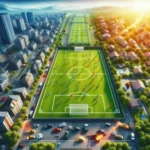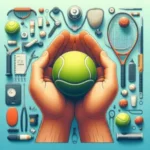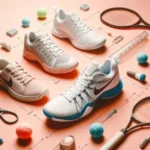Tennis, often dubbed the sport of kings, is as much about strategy and skill as it is about the surfaces on which it’s played.
From the lush, green grass of Wimbledon to the gritty clay of Roland Garros, each court type has its own unique characteristics that significantly influence the style and pace of the game. As players adapt their techniques to match the nuances of the surface, the dynamics of rallies, serves, and even mental resilience shift dramatically. In this blog post, we’ll dive deep into the world of tennis court surfaces, exploring how grass, clay, and hard courts shape not just the gameplay, but also the athletes who compete on them. Whether you’re a seasoned player or a passionate fan, understanding the impact of these surfaces will enrich your appreciation for the game, revealing how every match is a complex dance between skill, strategy, and the very ground beneath the players’ feet.
1. Introduction to Tennis Court Surfaces
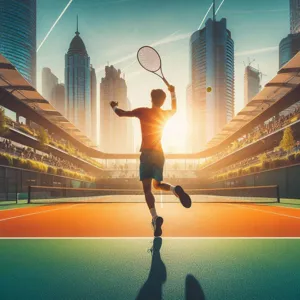
Tennis is a sport steeped in tradition, strategy, and athleticism, and one of the most fascinating aspects of the game lies in the various surfaces on which it is played. Each type of tennis court surface—be it clay, grass, or hard court—brings its own unique characteristics that significantly influence the dynamics of play. From the way the ball bounces to the speed of movement, these surfaces shape not only the strategies employed by players but also the overall spectator experience.
At first glance, tennis might seem straightforward, but the nuances of court surfaces can create a complex tapestry of styles and techniques. Clay courts, with their soft, forgiving texture, slow down the ball and create a higher bounce, favoring baseline rallies and long exchanges. Players who excel on clay often demonstrate incredible stamina and strategic finesse, as they must adapt their game to the demands of longer rallies and sliding movements.
In contrast, grass courts offer a completely different experience. The natural surface allows for a much faster game, where the ball skids through and points are won in quick succession. This surface historically favors serve-and-volley players who can take advantage of the speed and unpredictability of the bounce, often leading to thrilling, action-packed matches.
Hard courts strike a balance between the two, providing a consistent and versatile playing field that caters to a variety of playing styles. They can be found in both indoor and outdoor settings, and their medium pace allows for a diverse range of strategies, making them the most common surface for tournaments worldwide.
As we delve deeper into the world of tennis court surfaces, we will explore how each type not only shapes the game on a technical level but also influences player performance, fan engagement, and the history of the sport itself. From iconic tournaments played on these surfaces to the evolution of player strategies, understanding the impact of court surfaces is essential for any tennis enthusiast. Join us as we uncover the fascinating relationship between tennis and its playing environments, providing insight into how they contribute to the beautiful complexity of this beloved sport.
2. Overview of Different Types of Court Surfaces
When it comes to tennis, the court surface is a crucial factor that can dramatically influence the style of play, player performance, and match outcomes. Each type of surface brings its own unique characteristics, offering distinct challenges and advantages to players. Here’s a closer look at the three primary types of tennis court surfaces: grass, clay, and hard courts.
**Grass Courts**
Perhaps the most iconic of all surfaces, grass courts are synonymous with the prestigious Wimbledon Championships. This lush green surface allows for a fast-paced game, where the ball tends to skim low and quick due to the natural bounce of the grass. Players skilled in serving and volleying often thrive here, as the fast surface rewards aggressive play. However, grass courts can be notoriously unpredictable, especially after rain, making it essential for players to adapt quickly to changing conditions.
**Clay Courts**
Conversely, clay courts present a slower-paced game, offering a stark contrast to the speed of grass. The red or green clay allows for a higher bounce, which can be advantageous for baseline players who excel in long rallies and strategic shot placement. The slower surface tends to favor those with endurance and patience, as matches often become testaments to stamina and tactical prowess. Famous tournaments like the French Open are held on clay, showcasing the unique challenges and strategies that come into play on this surface.
**Hard Courts**
Hard courts strike a balance between grass and clay, providing a medium-fast playing surface that combines elements of both. This versatile surface is typically made from asphalt or concrete, resulting in consistent bounce and speed. Players like to utilize a mix of powerful serves and baseline play, making hard courts a favorite among many professional players. The US Open and the Australian Open, two of the four Grand Slam tournaments, are held on hard courts, highlighting the excitement and drama that this surface can produce.
Understanding these different court surfaces is essential for players, coaches, and fans alike. Each surface shapes not only the strategy and style of play but also the very essence of the match. Whether you prefer the lush elegance of grass, the gritty battles on clay, or the dynamic action of hard courts, the unique characteristics of each surface add layers of complexity to the beautiful game of tennis.
3. Hard Courts: Characteristics and Impact on Play
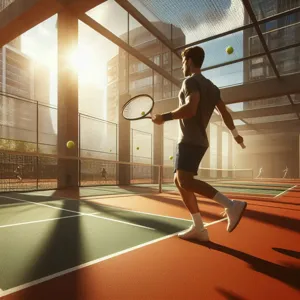
Hard courts are a staple in the world of tennis, known for their unique blend of speed and consistency. Typically constructed from a mixture of asphalt and concrete, these surfaces provide a firm, flat base that allows for a balanced playing experience. The surface is often coated with a layer of acrylic or latex, which not only enhances durability but also influences the ball’s bounce and speed.
One of the defining characteristics of hard courts is their relatively fast playing speed. The consistent surface allows for a predictable bounce, enabling players to execute a wide range of strokes with precision. This predictability encourages aggressive play, as competitors can confidently engage in baseline rallies or transition to the net. Players like Novak Djokovic and Serena Williams have thrived on hard courts, utilizing their powerful serves and swift groundstrokes to dominate matches.
However, the benefits of hard courts come with a few challenges. The unforgiving nature of the surface can lead to increased impact on players’ joints, making it crucial for athletes to prioritize fitness and injury prevention. Additionally, the speed of the surface places a premium on reaction time and shot placement, often favoring those with exceptional athleticism and tactical awareness.
The impact of hard courts on playing style is undeniable. Unlike clay, which slows the game and rewards baseline rallies, or grass, which allows for quick points and serve-and-volley tactics, hard courts strike a balance that encourages a hybrid approach. This surface supports both aggressive baseline play and strategic net approaches, making it a favorite among fans and players alike. As the tennis calendar unfolds, the hard court season—particularly the Grand Slam events like the US Open and the Australian Open—provides thrilling displays of athleticism and strategy that showcase the unique characteristics of this dynamic surface.
4. Clay Courts: The Unique Challenges and Advantages
Clay courts, with their distinctive reddish-brown hue and textured surface, offer a unique playing experience that challenges even the most seasoned tennis players. Unlike grass or hard courts, clay surfaces are made of crushed brick, shale, or stone, which not only alters the speed of the game but also influences the ball’s bounce and the players’ movement.
One of the most significant challenges of playing on clay is the slower pace of play. The surface absorbs much of the ball’s energy, resulting in longer rallies and a more strategic game. Players must adjust their tactics, often employing a more patient and defensive style, as points can extend significantly longer than on other surfaces. The high bounce, often unpredictable, forces athletes to stay light on their feet and ready for anything, requiring impeccable footwork and shot placement.
However, the advantages of clay courts cannot be overlooked. The surface allows players to slide into their shots, a skill that can be both a thrilling spectacle and an essential technique. This sliding can create angles and opportunities that are less accessible on faster surfaces. Additionally, the softer nature of clay is gentler on the joints, potentially reducing the risk of injury during long matches.
Clay courts also have a rich history and a unique culture, exemplified by the prestigious French Open at Roland Garros, where the red clay has become synonymous with legendary matches. Players must not only master their skills but also embrace the mental fortitude required to thrive in this environment. Adapting to the unique challenges and advantages of clay courts can transform a player’s game, making it a fascinating aspect of tennis that continues to captivate both athletes and fans alike.
5. Grass Courts: Tradition and Speed in the Game
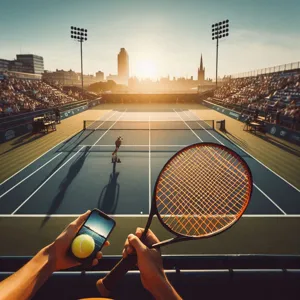
Grass courts are the epitome of tennis tradition, steeped in history and characterized by their lush, verdant surfaces. As the fastest of all court types, grass significantly influences the dynamics of play, offering a unique blend of speed and unpredictability. The moment a tennis ball makes contact with the soft, natural turf, it behaves differently compared to other surfaces. The grass allows for a lower bounce, which can catch even the most seasoned players off guard. This rapid pace rewards aggressive play and quick reflexes, often favoring serve-and-volley styles that keep the action at the net.
In contrast to the more consistent bounce of clay or hard courts, grass introduces an element of variability; the condition of the surface can change dramatically from match to match, influenced by factors such as weather and foot traffic. A freshly mowed court offers a smooth playing experience, while worn areas can create unpredictable patches that can alter the trajectory of the ball. This unpredictability adds a layer of strategy, compelling players to adapt their techniques on the fly.
Historically, grass courts have been synonymous with prestigious tournaments like Wimbledon, embodying a sense of elegance and tradition that elevates the sport’s profile. The sight of players clad in white, competing on the iconic green backdrop, is a cherished image in the world of tennis. Yet, while grass may hold a revered place in the sport’s history, it also demands a unique skill set. Players must master the art of sliding, adjusting their footwork to accommodate the different speed and bounce, while also maintaining a sharp focus to anticipate the ball’s unpredictable movement.
In essence, grass courts encapsulate the very spirit of tennis: a blend of tradition, skill, and adaptability. As players traverse this dynamic surface, they not only engage in a battle of athleticism but also pay homage to the rich heritage of the game. Whether it’s the thrill of an ace that skims past an opponent or the tension of a long rally that tests endurance, grass courts serve as a canvas where the beauty and complexity of tennis truly come to life.
6. The Science Behind Court Surface Materials
When it comes to tennis, the surface upon which the game is played can dramatically influence the dynamics of play, shaping everything from ball speed to player strategy. Understanding the science behind court surface materials unveils the intricate relationship between physics and sport, revealing how each surface type affects the ball’s behavior and the players’ movements.
**Grass Courts:** Known for their lush green appearance, grass courts are made from natural grass and are characterized by their fast-paced play. The soft surface allows for a lower bounce, which can catch players off guard and reward aggressive serve-and-volley tactics. The composition of the grass—typically a mix of perennial ryegrass and other hardy species—affects the court’s adherence and speed. The grass must be maintained meticulously, with regular mowing and watering to ensure optimal playing conditions. This surface encourages quick matches where finesse often trumps endurance.
**Clay Courts:** In sharp contrast, clay courts, made from crushed stone or brick, create a slower, more strategic game. The texture of the clay allows for higher bounces, demanding players to develop longer rallies and rely on consistent footwork. The scientific aspect here involves how the loose particles of clay interact with the tennis ball; the grit creates friction that can alter the ball’s spin and trajectory. Players on clay courts often become experts in patience and endurance, as the slower pace allows for intricate play and tactical positioning. Additionally, the ability to slide on the surface can enhance a player’s movement, adding a unique dimension to their game.
**Hard Courts:** Perhaps the most versatile surface, hard courts are typically made from asphalt or concrete, often with an acrylic layer to provide texture and cushioning. This material offers a balance between the speed of grass and the slow pace of clay. The surface is designed to create a consistent bounce, which can significantly affect player strategy. On hard courts, the ball tends to maintain its speed, allowing for a faster-paced game that can favor powerful baseline players. The science behind hard courts lies in the material’s ability to absorb shock and reduce fatigue, thereby enhancing players’ performance over long matches.
In conclusion, the choice of court surface not only impacts the immediate gameplay but also influences the training regimens and strategies of players. By understanding the science behind these materials, players and fans alike can appreciate the nuances that differentiate each surface, deepening their love for the game of tennis. Whether it’s the grass, clay, or hard court, each surface presents its own unique challenges and opportunities, adding layers of complexity to this beloved sport.
7. How Surface Affects Player Performance and Style

The surface of a tennis court plays a pivotal role in shaping not only the dynamics of the game but also the performance and style of individual players. Each type of court surface—be it clay, grass, or hard court—exerts unique influences on how the ball behaves, how players move, and ultimately, how they strategize during a match.
On clay courts, the soft, granular surface slows down the ball and produces a higher bounce, favoring baseline rallies and strategic shot placements. Players who excel on clay tend to adopt a more patient, defensive style, often engaging in long rallies that test their endurance and tactical acumen. Think of Rafael Nadal, whose unparalleled success on clay can be attributed to his relentless grinding style and unparalleled ability to construct points meticulously. The slower nature of clay allows players to set their rhythm, making it essential for them to be able to outlast their opponents in extended exchanges.
Conversely, grass courts offer a rapid playing surface that rewards aggressive play and quick reflexes. The ball skids and bounces lower, often leading to shorter rallies and encouraging players to approach the net. This surface is a playground for serve-and-volley specialists like Pete Sampras and Roger Federer, whose powerful serves and deft net play have made them icons of grass-court tennis. The unpredictable nature of grass can lead to thrilling matches characterized by fast-paced exchanges and acrobatic volleys, showcasing the athleticism and instinct of the players.
Meanwhile, hard courts present a balanced compromise between the two extremes, offering a fast yet predictable surface. This versatility allows players to adopt various styles—whether it’s the baseline power of Serena Williams or the all-court game of Novak Djokovic. The consistent bounce of a hard court enables players to execute a wide range of shots effectively, making it a favorite for many players who thrive on adaptability.
Understanding how different surfaces affect player performance and style not only enriches our appreciation of the game but also highlights the necessity for players to adapt their training and strategies accordingly. The interplay between surface, performance, and style adds layers of complexity to tennis, ensuring that every match is not just a contest of skill, but a captivating dance between player and court.
8. Famous Tournaments and Their Surfaces
When it comes to tennis, the surface of the court plays a pivotal role in shaping the dynamics of each match, influencing the players’ strategies, styles, and even outcomes. Throughout the tennis calendar, several prestigious tournaments stand out, each associated with a specific type of court surface that profoundly impacts how the game is played.
**Wimbledon** is perhaps the most iconic of them all, taking place on lush, green grass. The natural surface lends itself to a fast-paced game, where players who excel in serving and volleying often have the upper hand. The grass court allows the ball to skid low, rewarding aggressive play and putting a premium on precision. As the oldest tennis tournament in the world, Wimbledon is steeped in tradition, with its pristine white attire rules and the gentle sound of grass beneath players’ feet creating a unique atmosphere that is distinct from any other event.
In contrast, the **French Open** showcases the beauty of clay courts at Roland Garros. Clay is known for its slower speed and higher bounce, which encourages longer rallies and strategic play. This surface is particularly favored by players with exceptional baseline skills and stamina, as it demands a different kind of agility and shot placement. The red clay also adds an element of artistry to the game, as players leave their marks with vibrant streaks of dirt—a testament to the physicality required to master this surface.
Then there’s the **US Open**, played on hard courts, which combines elements of both grass and clay. The hard surface offers a medium pace that provides a balanced playing field for all types of players. The quick bounce allows for powerful serves and aggressive baseline play, making it a favorite among fans for its thrilling, high-energy matches. The hard courts at Flushing Meadows challenge players to adapt quickly, as they must find their rhythm amidst variable conditions influenced by the weather and time of day.
Finally, the **Australian Open** also takes place on hard courts, but with a distinct composition that affects the ball’s behavior. The court surface tends to be slightly faster than that of the US Open, rewarding players who can power through their shots while remaining agile. The scorching heat of the Australian summer adds another layer of complexity, testing the athletes’ endurance and mental fortitude.
In summary, each of these grand tournaments not only celebrates the sport of tennis but also highlights the critical role that court surfaces play in shaping the matches. Understanding how these surfaces affect gameplay gives fans a deeper appreciation for the athletes’ skills and strategies, making each tournament an exhilarating experience that is as much about the game as it is about the environment in which it is played.
9. Historical Evolution of Tennis Court Surfaces
The historical evolution of tennis court surfaces is a fascinating journey that reflects not only the sport’s development but also the cultural and technological advancements of society. The origins of tennis date back to the late 12th century, where it began as a game played with the palm of the hand against a wall in France. As the sport evolved, so did the surfaces on which it was played, transitioning from the rudimentary grass and clay of medieval courts to the sophisticated materials we know today.
In the late 19th century, lawn tennis emerged as a popular pastime among the British elite, leading to the establishment of grass courts that became synonymous with prestigious tournaments like Wimbledon. These lush, green surfaces offered a unique playing experience characterized by rapid ball speeds and low bounces, favoring players with strong serve-and-volley tactics. The grass courts required meticulous maintenance, reflecting the social status of those who played on them.
As tennis spread globally, so did the experimentation with alternative surfaces. The introduction of clay courts, primarily in France, marked a significant shift in gameplay dynamics. Clay, with its slower surface and higher bounce, encouraged longer rallies and strategic baseline play. The French Open, held on red clay, has become a testament to the unique challenges and skills required to master this surface. Players like Rafael Nadal have demonstrated the art of playing on clay, showcasing how surface preference can elevate one’s game.
The 20th century saw the rise of indoor courts and the invention of synthetic surfaces, leading to the creation of hard courts that now dominate the professional circuit. These surfaces, which blend durability and consistency, have become the standard for numerous tournaments, including the US Open and the Australian Open. Hard courts offer a balanced playing field that accommodates a variety of playing styles, making them a favorite among fans and players alike.
Today, the landscape of tennis court surfaces continues to evolve, with ongoing innovations aimed at enhancing player safety and performance. From the emergence of hybrid surfaces that combine the characteristics of grass and hard courts to the growing popularity of eco-friendly materials, the evolution of tennis surfaces reflects a broader trend toward sustainability in sports. As we look to the future, one thing remains clear: the surface on which the game is played will always shape the strategies, skills, and thrilling moments that make tennis such a beloved sport worldwide.
10. Surface Preferences of Top Players
When it comes to tennis, the surface underfoot can significantly influence a player’s performance, strategy, and overall game. Top players often have distinct preferences for specific surfaces, shaped by their playing style, physical attributes, and even psychological factors. For instance, clay courts, with their slower pace and higher bounce, tend to favor players who excel in baseline rallies and possess exceptional stamina and tactical acumen. Rafael Nadal, often dubbed the “King of Clay,” has dominated this surface throughout his career, showcasing his powerful topspin and relentless court coverage.
On the other hand, players like Roger Federer thrive on grass courts, where the quick, low bounce enhances their serve-and-volley game. Federer’s fluid movement and precision serve make him a formidable opponent on this surface, allowing him to dictate play and finish points swiftly. Grass courts reward players who can adapt rapidly and exploit the surface’s unique characteristics, making it a true test of skill and finesse.
Hard courts, the most versatile surfaces, attract players with diverse styles. They offer a balanced combination of speed and bounce, allowing for aggressive play while still accommodating those who prefer longer rallies. The likes of Novak Djokovic have found immense success on hard courts, blending powerful groundstrokes with incredible defensive skills.
Understanding these surface preferences not only highlights the unique attributes of each player but also shapes tournament strategies and fan expectations. As the tennis calendar unfolds, watching how top athletes adapt their games to different surfaces adds an exciting layer to the sport, reminding us that in tennis, the court beneath your feet can be as pivotal as the racket in your hand.
11. Strategies for Different Court Surfaces
When it comes to tennis, the surface of the court plays a crucial role in determining the style of play and the strategies that players employ. Each surface—be it grass, clay, or hard court—comes with its unique characteristics that can dramatically influence the game’s dynamics. Understanding these nuances is essential for players looking to gain an edge over their opponents.
**Grass courts**, known for their fast-paced play and low bounce, favor aggressive players who can serve well and rush the net. The grass’s slick surface makes it easier to hit aces and volley effectively. Players on this surface should focus on honing their serve-and-volley skills and developing a strong, accurate serve. To counteract opponents on grass, players should adopt a more aggressive baseline game, aiming to take control of points early and minimize rallies.
**Clay courts**, on the other hand, present a different set of challenges. The slower surface results in higher bounces, which allows players more time to react and set up their shots. This surface is ideal for constructing points through strategic shot placement and endurance. Players should focus on developing a solid baseline game, utilizing topspin to keep the ball in play and pushing opponents from side to side. Patience becomes a key strategy on clay, as longer rallies can wear down opponents, ultimately leading to unforced errors.
**Hard courts** sit in the middle of the spectrum, combining elements of both grass and clay. They provide a consistent surface that can facilitate a variety of playing styles, from aggressive baseline rallies to net play. Players on hard courts should be versatile, adapting their strategies based on their opponent’s strengths and weaknesses. Emphasizing footwork and shot placement is vital, as the court allows for both power and finesse. The ability to transition quickly from baseline rallies to the net can be the difference between winning and losing on this surface.
In conclusion, successfully navigating the complexities of different tennis court surfaces requires a strategic mindset. By adapting their game and honing specific skills tailored to each surface, players can enhance their performance and increase their chances of victory. Whether it’s the quick, slippery grass, the slow, strategic clay, or the balanced hard court, understanding these surface-specific strategies is essential for any tennis player looking to elevate their game to new heights.
12. Injury Considerations Across Surface Types
When it comes to tennis, the surface on which the game is played significantly influences not only the style of play but also the risk of injury for athletes. Each court surface—be it grass, clay, or hard court—has its own unique characteristics that can impact a player’s movement, balance, and overall physical strain.
Grass courts, famous for their lush, green aesthetics, provide a fast-paced game with a low bounce. However, this can lead to a higher risk of ankle sprains and knee injuries as players make rapid lateral movements on a softer, often slippery surface. The variable footing can catch players off guard, especially during wet conditions, leading to potential falls or missteps.
Clay courts, on the other hand, are renowned for their slower pace and high bounce, allowing players to engage in longer rallies. While this surface can be gentler on the joints, it can still pose its own injury risks. The sliding technique required on clay can lead to overuse injuries, especially in the knees and hips. Players may find themselves susceptible to muscle strains due to the repetitive nature of the slides and hard stops.
Hard courts, commonly constructed from asphalt or concrete, strike a balance between the two extremes. While offering consistent bounce and reliable footing, they can also be unforgiving on the body. The rigid surface can exacerbate the impact on players’ joints, leading to conditions such as tennis elbow or Achilles tendonitis. The added stress on the knees and back can result in chronic pain if players do not take proper care of their bodies through injury prevention strategies and recovery practices.
Understanding these injury considerations across different surfaces is crucial for players at all levels. It informs their training regimens, footwear choices, and even match strategies. An awareness of the unique demands each surface places on the body can empower athletes to make informed decisions, thereby not only enhancing their performance but also prolonging their careers on the court. Ultimately, the conversation around injury risks serves as a reminder that while tennis is a sport defined by skill and strategy, the importance of physical health and safety should never be underestimated.
13. The Future of Tennis Court Surfaces
As we look towards the future of tennis court surfaces, innovation and sustainability are becoming key drivers in the evolution of the game. With advancements in technology and a growing awareness of environmental impact, manufacturers are exploring new materials and designs that promise to enhance player experience while minimizing ecological footprints.
One exciting trend is the development of hybrid surfaces that combine the best features of traditional materials. Imagine a court that has the shock absorption of clay but the speed of grass—these hybrid surfaces not only provide a unique playing experience but also cater to the diverse needs of players at all levels. Such innovations could change the way the game is played, allowing players to adapt their styles and strategies based on the characteristics of the surface beneath their feet.
Additionally, there is a growing push for eco-friendly materials in the construction of tennis courts. From recycled rubber to sustainably sourced wood, the industry is beginning to embrace greener alternatives that reduce waste and carbon footprints. This shift not only meets the demands of environmentally conscious players and fans but also sets a precedent for other sports to follow.
Furthermore, the impact of climate change on playing conditions cannot be ignored. As weather patterns shift, the adaptability of court surfaces may become increasingly important. Future developments might include surfaces that are resistant to extreme weather conditions, ensuring that matches can proceed regardless of rain or heat, thereby reducing interruptions in professional circuits.
In summary, the future of tennis court surfaces promises to be dynamic and responsive to both player needs and environmental concerns. As we continue to innovate, the game of tennis will not only evolve in terms of how it is played but also in how it aligns with our planet’s health, ensuring that it remains a beloved sport for generations to come.
14. Conclusion: Finding Your Surface Preference
In the world of tennis, the choice of playing surface is not merely a matter of preference; it profoundly influences gameplay, technique, and strategy. As we’ve explored, each surface—be it the fast-paced hard courts, the lush and unpredictable grass, or the slower, more grueling clay—offers unique characteristics that can elevate or challenge a player’s skills.
Finding your preferred surface is akin to discovering your playing identity. Do you thrive on the quick reactions and powerful serves that hard courts demand, or do you relish the tactical battles and longer rallies that clay courts provide? Perhaps the artistry of movement on grass, with its swift points and nuanced shots, captures your heart.
For aspiring players and seasoned pros alike, it’s essential to experiment across different surfaces to understand how they impact your game. Each court type requires a different mindset and skill set, and recognizing your strengths and weaknesses can be pivotal in elevating your performance.
Ultimately, the beauty of tennis lies in its diversity. Embrace the challenge of each surface, learn from the intricacies they present, and allow your experiences to guide you toward your ideal playing environment. Whether you’re chasing trophies or simply enjoying a casual game with friends, your surface preference will shape not only your strategy on the court but also your overall love for the sport. So, lace up your shoes, grab your racket, and step onto the court that resonates with you—your game awaits!
15. Additional Resources for Tennis Players and Fans
For those eager to deepen their understanding of tennis and enhance their skills on the court, a wealth of resources is available for both players and fans alike. Whether you’re a novice looking to refine your fundamentals or a seasoned player aiming to master the nuances of your game, these resources can be invaluable.
**Books and Manuals**: There’s a plethora of books that delve into the techniques and strategies of tennis. Classics like “Winning Ugly” by Brad Gilbert offer insights into the mental aspects of the game, while instructional manuals provide step-by-step guides to improving your strokes and footwork. For fans, autobiographies of legendary players such as Andre Agassi and Serena Williams not only chronicle their journeys but also impart valuable lessons about resilience and perseverance.
**Online Courses and Tutorials**: The digital age has ushered in a host of online platforms offering video tutorials and courses tailored for all skill levels. Websites like Tennis.com and YouTube channels dedicated to tennis instruction cover everything from basic serves to advanced strategies. Engaging with these resources allows players to visualize techniques and apply them practically on the court.
**Tennis Clubs and Local Leagues**: Joining a local tennis club or league can provide not only practice but also a sense of community. Many clubs offer workshops, coaching sessions, and social matches, allowing players to learn from experienced coaches and connect with fellow tennis enthusiasts. Being part of a community can also keep you motivated and accountable in your training.
**Podcasts and Blogs**: For fans wanting to stay updated on the latest in the tennis world, podcasts and dedicated blogs offer a treasure trove of information. From in-depth discussions on recent matches and player performances to analyses of court surfaces and their effects on gameplay, these platforms keep you informed and engaged. Listening to expert commentary can enhance your appreciation of the sport and its intricacies.
**Apps and Training Tools**: Technology has made its mark on tennis training, with numerous apps designed to track performance, analyze swings, and even connect players for practice matches. Tools such as video analysis software can help players dissect their gameplay, allowing for targeted improvement in specific areas.
By utilizing these resources, both players and fans can amplify their enjoyment and understanding of tennis. The game is as much about continuous learning and adaptation as it is about competition, and these tools can enhance your journey, whether you’re on the court or cheering from the sidelines.
As we conclude our exploration of how different tennis court surfaces shape the game, it’s clear that the choice of surface can profoundly influence not just player performance but also the overall dynamics of the sport. From the blistering speed of hard courts to the unique challenges posed by grass and the strategic nuances of clay, each surface offers its own set of advantages and intricacies that can elevate or hinder a player’s game. Understanding these differences not only enriches your appreciation for tennis but also equips you with vital insights as you watch your favorite players compete. Whether you’re an aspiring tennis star or a dedicated fan, recognizing how court surfaces impact gameplay can deepen your connection to this incredible sport. So the next time you tune in for a match, remember: the surface beneath their feet is just as critical as the skills they bring to the court. Happy watching!


